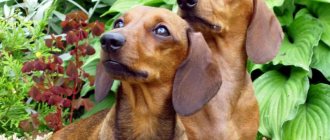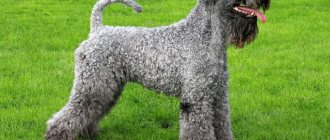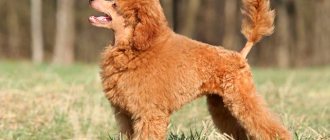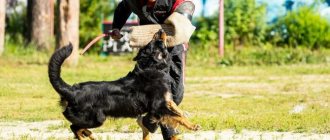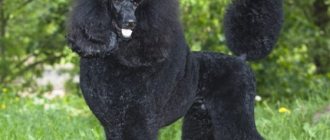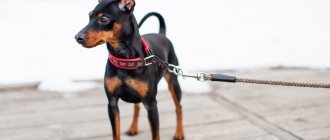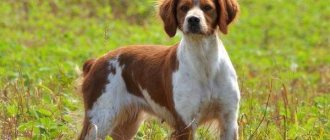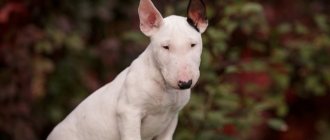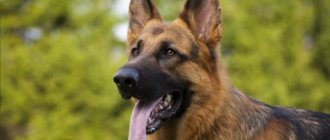Before taking an animal into your home, it is important to clearly balance your desires with your capabilities. It is strictly forbidden for older people to adopt active dogs. This neighborhood will bring more discomfort than joy. The dachshund is one of these breeds. She has an innate hunting instinct, and it is terribly uncomfortable for an adult dog to be in an apartment.
Speed and constant movement are in the blood of representatives of this breed.
History of the breed
Dogs of this breed have existed alongside humans for many centuries; Germany is considered to be their homeland. They first appear in documentary sources more than 500 years ago. Dachshunds are descendants of marriages - hunting dogs with excellent scent and endurance. Thanks to persistent selection, the dachshund acquired its modern appearance,
On a note! The species closest in natural skills to dachshunds is the Russian terrier.
To work on the hare, targeted work was carried out to breed more miniature representatives of the species. For this purpose, the smallest dogs from different litters were crossed over many generations.
In the modern world, many owners get a dachshund as a companion dog or simply for decorative purposes.
The dachshund has been used since ancient times to help hunters
How much does a puppy cost?
The price for miniature dachshunds ranges from 200 to 1000 dollars (from 1,500 to 65,000 rubles). It all depends on the origin of the dog, the blood that flows in it, and the breeder’s views on this or that puppy. The simpler the dog, the cheaper it is.
Keep in mind that, as a rule, the best puppy stays with the breeder. Or sold to someone you know. This does not mean that a stranger will be handed a terrible dog. Not at all. It’s just that the “stars” are given to those who have experience in keeping and raising dogs.
Description of the breed
What is the difference between a dachshund and a mini dachshund? Thanks to the existing division of the breed, there are three varieties to which the pet can be classified:
- standard;
- dwarf;
- rabbit
At the same time, the dwarf variety weighs up to 4 kilograms, the chest should not exceed 35 cm in girth. The height at the withers should not be more than 22-27 for boys and 16-21 cm for girls.
If the pet exceeds these parameters, then it is classified as a standard dachshund.
If the chest circumference is up to 30 cm, the height of a boy is 12-15 cm, and that of a girl is 10-13 cm, with a weight of 3.5 kg, the dachshund is classified as a rabbit.
Chest circumference is measured when the animal reaches the age of 15 months. Based on it, a conclusion is made about belonging to a certain variety and an entry is made in the pedigree.
Important! Even if rapid growth follows in the future, the miniature dachshund will remain a dwarf according to documents.
Representatives of the breed differ not only in size, but also in color.
Breed card
- Known breed names: Dackel, Dachshund, Teckel
- FCI breed number: 148
- Description of the standard on the FCI website: link
- Height at withers: up to 21 cm
- Adult dog weight: up to 5 kg
- Color options: solid, two-tone
- Lifespan: up to 15 years
- Puppy cost: 20,000-38,000 rubles
- Size: 2 out of 5
- Learning ability: 4 out of 5
- Attitude towards children: 4 out of 5
- Shedding intensity: 2 out of 5
- Protective and guard qualities: 4 out of 5
Breed characteristics
According to the observations of dog breeders, throughout history the dachshund has undergone virtually no changes either in appearance or in character traits. Features of the breed include:
- The dog steadfastly overcomes difficulties.
- Perky disposition.
- Most dachshunds become very attached to one owner.
- Funny looking pet.
Whatever species the dachshund belongs to, it has a dense, elongated body. The hallmark of the breed is its short legs. Although the dog gives the impression of a clumsy creature at first glance, it is unusually mobile and has excellent control of its body.
We should not forget that the decorative dachshund is, first of all, a hunting dog. Therefore, in many countries, when breeding it for hunting, it is required to show its ability to work in a hole and pull prey out of it. For this purpose, man-made tunnels are used that imitate natural burrows. The ability to keep track is also important for a hunter.
Personality of the Miniature Dachshund
Representatives of the miniature variety are distinguished from standard dachshunds not only by their size, but also by their more explosive temperament. Although the breed was never bred for hunting in Russia, the working talents of the “dwarfs” have not atrophied, so they continue to use them wherever the opportunity arises. As an example: miniature dachshunds have a heightened protective instinct, which they do not hesitate to “turn on” several times a day.
If the pet urgently needs a release, and there is no suitable threat nearby, the brave short-legged one will invent an enemy for himself, whom he will immediately bark loudly. During walks, dwarf dachshunds remember their historical purpose and willingly poke their noses into every hole. It is also a matter of honor for the breed to terrorize frogs, rodents and chicks that come their way, so do not regard such attacks as obstinacy and bad manners of the animal. Miniature dachshunds can't do it any other way.
In their youth, many representatives of the breed are guilty of destructive behavior. Basically, bursts of negative activity are typical for individuals who take little and unproductive walks and are often forced to remain alone, so if your dachshund has started “renovating” the apartment and is removing wallpaper from the walls, there is reason to think about it. It is quite possible that it is not the pet that is to blame for this mess, but his reclusive lifestyle and your own laziness. As the animal grows older, its internal battery begins to operate in energy saving mode. Take such changes calmly: the dog still won’t turn into a couch potato, it will just turn on the “alarm” a little less often.
Speaking of sofas: dwarf dachshunds are not averse to lying on them, but the breed likes games and active pastime more. The cunning “sausages” also establish contact with children one or two times, but with one caveat: the younger generation should not demonstrate their own superiority over the pet. In their hearts, most dwarf dachshunds consider themselves equal to their owner, leaving a lower level of the hierarchical ladder for the rest of the family. Don’t forget that all representatives of the breed are great artists when it comes to any benefits for them. Dachshunds who have received a scolding from their owner love to give their faces a mournful expression and press for pity. By begging for an extraordinary walk or a tasty treat, the dog also demonstrates miracles of cunning and ingenuity, which inexperienced owners often “buy in.”
Breed standard
Any deviations from the breed standard will result in immediate disqualification.
There are standards for the breed; only those dogs that fully comply with them can be allowed to compete.
Head
The wedge-shaped skull has a well-developed occipital region. The dachshund is characterized by a faint transition from the forehead to the muzzle. According to the standard, sharp points are unacceptable.
Jaws and teeth
The breed's well-developed jaws have excellent muscles. The teeth are tightly closed and strong.
Nose
Tapers towards the lobe, oval. Colors allowed are black and brown.
Eyes
The breed is distinguished by expressive oval-shaped eyes. The color is predominantly brown, but can also be caramel.
On a note! For marbled dachshunds, blue or cream eye color is allowed.
Ears
Long ears with rounded tips are shaped like a triangle.
Neck
The neck is set high and has pronounced withers and scruff.
Frame
A properly developed chest has an oval shape, developed in front. The long back ends in a sloping croup. The breed has a tucked belly as a standard.
Limbs
The legs are short and slightly curved in appearance. The hindquarters should be well spaced. Tightly collected brushes are distinguished by strength.
Tail
The tail according to the standard is located lower than the line of the vertebrae. Depending on the dog's mood, it can be raised or dangling.
Wool
The breed has different coat types. The dwarf smooth-haired dachshund has a short, glossy coat. Long-haired individuals have wavy and shiny fur, with longer fur on the paws, chest and neck. Wire-haired specimens, combined with short and coarse hair, have a rather soft undercoat.
Color
Regardless of the type of coat, the breed allows a wide variety of colors. Dachshunds are:
- various shades of red;
- black;
- gray;
- chocolate.
Spots on the front and hind legs, muzzle and other parts of the body are also allowed.
For your information! The breed standard allows for merle coloring and tan marks - black ends of the hair.
Distinctive features
There is no separate standard for the Miniature Dachshund. It is a subspecies of the standard breed and is considered its smaller copy: it reaches only 14-21 cm at the withers and weighs 4-5 kg. In addition to height variation, there are varieties based on coat length: smooth-haired, long-haired and wire-haired.
All Dachshunds are distinguished by a very elongated format, low stature and short legs. A similar physique can also be seen in the Basset Hound; in other breeds such parameters are considered defects. The proportions and shape of individual body parts are the same among the subspecies of the breed.
- The head is long, conical, tapering towards the nose. The stop is smooth, the brow ridges are pronounced.
- the muzzle is equal to the length of the skull. The jaw is strong with a full set of teeth and a scissor bite (the upper teeth closely overlap the lower teeth). Lips are thin.
- The nose is large. The color depends on the coat color.
- The eyes are small, almond shaped, set wide and slanting. Chocolate iris .
- The ears are set high, drooping, rather long and thin, rounded at the ends.
- The body is muscular, strong, elongated. The topline is straight and long, the withers are pronounced. The chest is well dropped . The neck is long, carried proudly and without dewlap.
- The tail is short, does not touch the ground, and is set below the back.
- The limbs are short, set wide and straight. The paws are large, powerful, oval with pointed toes. Movements are smooth, hobbling, jerking.
- The smooth-haired coat is: close-lying, straight, fine, smooth; Wire -haired : thick, wiry with dense undercoat; Long -haired : shiny, medium-length, wavy, soft, with a fluffy undercoat.
- Colors. Solid: brown, black, red, sand, bi-color: black and tan or brown and tan, merle: black, auburn or gray with spots, brindle
Character
The breed is distinguished by its devotion to its owner; the dachshund is a gentle and affectionate dog. She copes well with the role of a pet. However, the presence of children and other pets makes her aggressive - jealousy does not allow her to share her owner's love with someone else.
Although the mini dachshund is a good-natured and cheerful creature, we should not forget that the hunter genes can wake up at any moment. This breed requires attention; if it is lacking, the pet becomes aggressive and embittered. This can lead to conflicts with other animals, as well as aggression towards the owner and destruction of the home.
Important! If you are unable to spend a lot of time with your pet, you should think carefully before getting a puppy of this breed.
For hunting, the dwarf dachshund has character traits such as passion for work and perseverance, which are emphasized by excellent endurance and excellent sense of smell.
Its size does not allow the use of a dachshund as a guard, although it can perfectly notify with its voice the appearance of strangers.
Basically, the dachshund is a cutie, but with a core inside.
Dwarf dachshund: character
Given the small size of the long-haired dachshund, most people will probably not be able to take the dwarf dachshund seriously, although in reality it is quite a dangerous and very biting animal.
It is because of this misleading impression that people harm themselves. Seeing a tiny dog on a leash nearby, a person may have a desire to pet it, but this does not lead to what he expects - a painful bite on the hand, and sometimes on the face. Usually those people who do not understand how to treat these cute dogs suffer in this way. Many owners know that dachshunds are very loyal creatures , who at the same time are always on guard when strangers and unfamiliar people approach them. And today, dachshunds are one of the most popular breeds for keeping in apartment conditions.
If we look at statistics, these short-legged hunters commit about 20% of all dog bites. But the long-haired mini dachshund is a very inquisitive animal and always responds positively to an offer to go for a walk or travel. If you are the owner of a personal plot and you decide to work in the garden bed, then keep in mind that at that very moment there will be a dachshund somewhere nearby. At this time, she can do a variety of things - help you plant seedlings, take an interest in the contents of the prepared holes, or sit nearby in the shade and watch you from afar.
Long-haired dachshunds are quite funny creatures that are ready to convey their cheerful mood to the owner. And games are one of her favorite pastimes. Therefore, if something saddens you, you can easily cheer yourself up if you spend a couple of minutes with this dog. But we advise you to refrain from raising your voice or using physical force against your dachshund. This will only make things worse and ruin your pet’s character. The dog may not perceive your attempts to scold him for any action in the way you expect, and may be offended. This is confirmed by numerous reviews, where owners indicate that one of the characteristic features of dachshunds is excessive touchiness.
If you do this unfairly to your pet, he will hide in a secluded corner and from there will look at you reproachfully. He may demonstrate this behavior for several days, waiting for you to finally apologize to him. From this we can draw only one conclusion - dachshunds are very intellectually developed animals. They can easily understand what is said to them, and therefore easily master various commands. Sometimes the owner gets the impression that his pet is ready to tell him something.
Education and training
When working with this breed, you should remember that they are very friendly, therefore they are very sensitive to the love and mood of the owner.
When raising a dwarf dachshund, you cannot use the method of reward and punishment. Of course, she should be praised for her successes, but she should absolutely not be punished. When training this dog, you should use ignoring instead of punishment; this method will give the best result.
Important! Frequent punishment can make a dog aggressive.
Training
The dwarf dachshund is very smart and will learn to follow many commands. Its upbringing should be done immediately after purchase. Teach your puppy the simplest commands through play. Start with training for three minutes, increase the time to 15 minutes. Give commands in a stern voice.
When done correctly, reward with a treat, praise, and pet the animal. When disobeying, speak in a confident, calm voice. You cannot beat, shout, or treat the dog roughly, otherwise it will lose trust in you and stop obeying you. Training can be done outside; your pet will happily run after a ball in the yard.
Maintenance and care
The principle of keeping almost any animal at home is essentially no different. A dog of any breed is quite demanding about its living conditions.
In order for a pet to grow up healthy, it requires constant care. This applies to places to sleep and eat. Anyone, even a novice dog breeder, should clearly understand that basic hygiene cannot be neglected, which consists of a lot of procedures that are vital for a pet at any age.
Content
What is needed to keep a small dachshund? A house or bed where your pet will rest from daily affairs. A bowl, or better yet two. In one, Her Highness is served with food, and the other serves to quench her thirst.
Your pet will appreciate the toys. Anything that can be bitten and torn will definitely undergo face control. More precisely, “tooth control”. And how much dachshunds love balls cannot be expressed in words. Buy a rubber ball on a string. You'll see for yourself.
The dog needs housing. This is understandable: you can’t put such a baby in a booth, and you can’t put it in an outdoor enclosure either. In cold weather, the delicate animal freezes. And all sorts of bells and whistles have long been invented for representatives of the show class. That is, clothes for a dachshund.
Do you want to please your little one with a beautiful dress? No problem. Does your pet need a sweater or raincoat? Please choose. There are both coats and overalls for miniature dachshunds. There are so many things you can find in online dog clothing stores. For people, there is probably less choice than for their faithful four-legged companions.
Hygiene
It is enough to brush a miniature smooth-haired dachshund twice a week with a brush. You will also have to trim your dog twice a year. The dwarf longhaired dachshund will require more attention - brushing will become a daily ritual.
Important! If you neglect to comb long hair, it will begin to mat.
It is often not advisable to bathe these dogs. This procedure is used if the pet is really dirty.
- Brushing your teeth should be done once or twice a week.
- Ears need to be cleaned every 5-7 days.
- Eyes are washed daily.
One of the mandatory procedures is nail trimming.
Features of walking dachshunds
It is worth considering that dachshunds are very active and energetic dogs, and they need the opportunity to splash out their energy. This is expressed in frequent active walks: half an hour at least three times a day. Although the rabbit dachshund can be litter trained due to its compact size, it should only be used during inclement weather.
Rabbit dachshund puppy
It is good if the dog has playmates, but it is advisable to make sure that they are not too large and strong in comparison with the short-legged dachshund. It is also worth considering that the owner will have to take an active part in walks: in the form of games. Dachshunds are great lovers of running, but you should let them off the leash with great care; they are capable of chasing small animals.
Walking, physical activity and rules of safe behavior on the street
Small dachshunds are like puppies - they are highly active and inquisitive. Therefore, they require daily walks. Normally, it is believed that three walks a day should total an hour. If you have time to walk more, that’s only a plus.
Walking should be carried out on a leash, because hunting instincts can take over at any moment, and chasing a captivated pet is still entertainment.
On a note! The dachshund is a miniature dog, so a leash with an automatic length lock is perfect for it.
For walks in the cold season, the short-haired dwarf dachshund may require the purchase of special clothing.
Features of character and behavior
Dachshunds are controversial dogs. On the one hand, these are small, cute, good-natured dogs with eternal optimism in their eyes and joy at the sight of a new person. On the other hand, these are brave hunters with a strong capricious character, primitive habits and open aggression towards those they do not like.
One way or another, puppies are very smart, quickly and easily trained, and adapt to different conditions. With proper upbringing, you can raise a good, faithful companion and assistant on the hunt.
Advantages
The clear advantages of the breed include:
- Sharp hunting instinct, good data: scent, hearing, speed;
- Security abilities are not inferior to large dogs;
- Friendliness, affection, devotion to family;
- Good relationships with children and pets (provided the animals grew up together);
- Activity, positivity, “ageless” soul;
- High intelligence.
Flaws
This is not the first year that this breed has graced the tops of the most aggressive dogs. There is some truth in this. Dachshunds are not very fond of strangers, members of the same sex, or annoying objects. Their nervous system is shaken, so cases of sudden aggressiveness cannot be ruled out. With proper parenting and proper upbringing, the chance of getting an uncontrollable, angry dog is minimal.
Common breed disadvantages include:
- Stubbornness, willfulness;
- Cunning, characterized by evasion of training and education;
- Tendency to escape;
- Destructiveness (like to gnaw, dig, drag, tear);
- Selfishness, jealousy of owners and personal items.
Features of feeding and diet
Most dog handlers recommend using premium professional food for feeding. There are special varieties on the market designed for small breed dogs. It will also be advisable to use not only dry, but also wet food.
If you decide to feed your dog natural products, you should adhere to the following diet:
- 50-60% of the daily diet should be meat;
- porridges should be predominantly buckwheat and rice, they are most suitable for dogs;
- Meals must include vegetables.
On a note! You can use barley or oatmeal no more than once a week.
It should be noted that the Dachshund is prone to overeating, so you should not abuse foods that can lead to excess weight gain. It is also necessary to decide on the portion size and feeding time, and then strictly adhere to these standards.
The health of your pet directly depends on your diet.
Dachshund weight table by month
The first thing dog owners need to know is that the average weight of dachshunds, miniatures, and standard dachshunds varies. Numbers for adult animals:
- Standard. Boys – 10 kg, girls – 9 kg.
- Dwarf. 4-5.5 kg.
- Rabbit. 2-3 kg.
As for the puppy’s weight, its gain is a consequence of a number of circumstances and factors: individual nuances of development, living environment, physical activity. However, a conscious owner must keep a diary of the development of his dachshund - periodically measure height and weight, enter these indicators and compare them with standard ones.
Below is a table of weights by month for standard dachshunds.
| Age | Weight (kg) |
| 1 Week | 0,2-0,3 |
| 2 week | 0,3-0,7 |
| 3 week | 0,6-1,1 |
| 1 month | 1,1-1,8 |
| 2 months | 2,1-2,9 |
| 3 months | 2,8-4 |
| 4 months | 4,1-5,4 |
| 5 months | 5,6-7,1 |
| 6 months | 7,2-8,5 |
| 7 months | 7,4-8,6 |
| 8 months | 7,4-8,8 |
| 9 months | 7,5-8,8 |
| 10 months | 7,7-9 |
| 11 months | 8,1-9 |
| 1 year | 8,5-9 |
Small deviations from standard indicators are not scary. If the puppy is active, cheerful, growing from month to month, and has an excellent appetite, there is no reason to worry. However, experienced owners advise: “it is better to underfeed a dachshund than to overfeed it.”
Excess weight has a number of negative consequences:
- Additional load on the spinal column. It can lead to both injury and displacement of the vertebrae.
- Diseases of the heart and blood vessels.
To prevent obesity, the first step is to introduce a strict feeding schedule depending on the age of the puppy:
- Up to 3 months – up to 6 times a day.
- 3-8 months – up to 4 times.
- From 8 months – up to 2 times.
It is important to pay attention to the volume of portions: per 1 kg of dog weight - no more than 40-50 g of food.
For the animal, they choose either premium food (canned food, dry croquettes) or completely natural food. From the 1st month, puppies are offered boiled vegetables and porridge, and from the 4th month - small pieces of lean raw meat.
Sample menu for a puppy:
- Raw or boiled meat (except pork).
- Porridge – buckwheat, rice, oatmeal (semolina is prohibited due to its high calorie content).
- Fermented milk products, cottage cheese (whole milk is prohibited).
- Boiled eggs (no more than 2 times a week).
- Boiled vegetables, raw carrots.
- Fruit pieces – Dachshunds love apples.
Taboos for dogs are treats from the human table, seasoned with spices, salt, sausages, raw fish, confectionery.
In addition to being overweight, the puppy may suffer from dystrophy. This is an equally serious problem that requires a visit to the veterinarian. The reasons for weight loss can be very diverse:
- Insufficient physical activity. If the kitten spends the whole day at home, lying down, he will probably lag behind in development. The young body is recommended for active and long walks, running, swimming, playing with a ball and a “flying saucer”.
- Worm infestation. To prevent infection, the owner monitors the frequency of deworming. The first procedure is 2 months before the first vaccination. If there are clear signs of worms, the medicine is given to very young puppies.
- Wrong menu. If the puppy is eating food, it may be necessary to switch to a higher calorie product. If the diet is natural, you should gradually increase the proportion of foods high in protein and calcium. Moreover, the emphasis is not on animal dishes, but on fermented milk.
- Deficiency of vitamins and mineral elements. Your veterinarian will prescribe the nutritional supplements needed for your specific puppy.
How to choose a puppy
If the task is to choose a dwarf dachshund puppy, then this should be done at about the age of 5 months. By this time, in most cases it is already possible to predict whether the dachshund will be standard, dwarf or rabbit.
All other tips relate to the general assessment of the puppy based on its appearance, the presence of disqualifying signs, developmental disabilities, as well as the emotional state of the pet. In this case, it is advisable to use the help of a breeder or an experienced dog handler. A purebred puppy can always be purchased at a specialized nursery.
On a note! Even a specialist cannot always guarantee what species the puppies will belong to. In a dwarf dachshund, the genes of their ancestors may awaken and the puppy will be standard, or maybe vice versa.
You cannot take a puppy without the appropriate documents.
Buying a puppy
You can buy a dwarf dachshund from a breeder or a nursery. Before purchasing, study the nuances of the appearance and content of the breed. The puppy can be taken from its mother no earlier than two months. When you arrive at the nursery, discuss with the breeder the puppy’s nutrition and living conditions. Ask for the parents' pedigrees and photographs. From the photo of the mother and father you can estimate the future size and prospects of the puppies. Having chosen a pet, agree on the purchase. Conclude a purchase and sale agreement and ask the breeder for a veterinary passport and puppy card. Additionally, you can ask for copies of the mother's and father's pedigrees.
Interesting Facts
One of the significant factors that allowed the breed to gain great popularity in England was that Queen Victoria herself was breeding dwarf dachshunds.
Another surprise for the owner may be the dog’s ability to dig tunnels. It costs nothing for a dachshund to dig a tunnel under the fence to the street if there is something there that interests him. Therefore, when choosing a place in the yard for your pet, it would be a good idea to remember this.
Pets painted in unusual colors are becoming increasingly popular. For example, the cost of a dwarf marbled dachshund is much higher than a dog with a classic color. At the same time, in some countries, white and beige coat colors are disqualifying.
Marble color dog
When purchasing such a pet, you should carefully evaluate your capabilities for maintaining it, so that the little nimble friend does not turn into a home destroyer.
Diseases and life expectancy
13 years is the average lifespan of a dwarf dachshund. Whether a pet can live longer depends on diet, activity and living conditions.
The dwarf dachshund has quite a lot of propensities for diseases.
- Obesity.
- Diabetes.
- Spinal diseases.
- Problem joints.
- Swimmer's syndrome.
- Eye diseases.
- Skin diseases.
- Dental problems.
- Epilepsy.
- Highly traumatic.
Mating
Before reaching 2 years of age, you should not breed a dwarf dachshund: the body and psyche are not yet fully formed, and early pregnancy will have a negative impact on both the mother and the offspring.
Before mating, it is advisable to visit a veterinary clinic for a comprehensive examination of the expectant mother, do tests, and treat the animal for fleas and parasites. During pregnancy, you cannot give your dog anthelmintics.
Mating takes place on the dog's territory - there he feels more comfortable. You may need the help of the owners to give the dogs the required position.
Pregnancy lasts 61-70 days. The period depends on the number of puppies. A dwarf dachshund usually gives birth to 2 to 4 babies.
Small dogs may have a difficult birth, so it is recommended to arrange in advance with the veterinarian about the possibility of an urgent call. There is no need to stock up on medications. Normally you won’t need them, but if problems arise and you have to use the services of a specialist, he will bring everything you need with him.
Vaccination
Vaccinations should not be neglected: they will develop immunity in the dachshund to serious diseases.
The first vaccination is carried out when the puppy is one and a half months old. Two weeks later - another one.
Vaccination against distemper is carried out at 2.5 months, repeated at 6-7 months, when the teeth have changed.
Before vaccination, deworming is necessary so that worms do not weaken the effect of the vaccine. After the procedure, you cannot walk or wash the puppy for 3 weeks.
Further procedures are carried out annually, as prescribed by a veterinarian.
